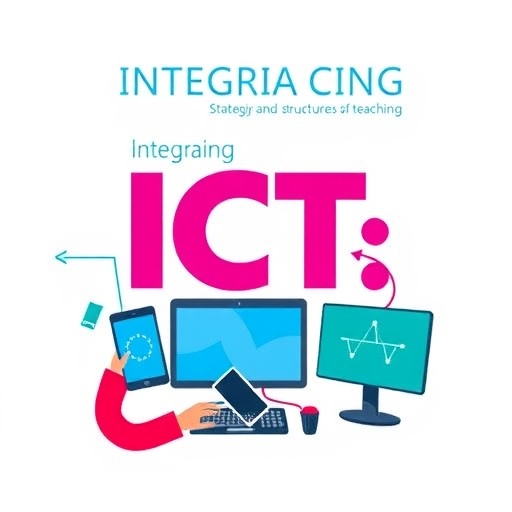In an era where technology is interwoven into the fabric of daily life, the integration of Information and Communication Technology (ICT) into educational practices is no longer an option but a necessity. Recent research highlights the foundational role that teaching practices and organizational aspects play in the effective use of ICT within the classroom. A comprehensive study, authored by scholars José Gil-Flores, José Rodríguez-Santero, and Carlos Ortiz-de-Villate, delves deep into this phenomenon, providing insights that can reshape the ways educational institutions approach technology in learning environments.
The integration of ICT in education has proven to enhance learning experiences, making them more interactive and engaging. But what factors contribute to the successful implementation of such technologies? The findings of the research emphasize that teacher training, institutional support, and the overall educational environment are pivotal in determining the effectiveness of ICT adoption in classrooms. Without adequately preparing educators to utilize these technologies, schools risk underutilizing valuable resources that could otherwise benefit students and facilitate a deeper understanding of complex subjects.
One of the core elements examined in the study is the importance of professional development for teachers. The authors argue that ongoing training and support can elevate teachers’ confidence and competence in using ICT tools. This is particularly relevant in a rapidly changing technological landscape where new tools and platforms emerge frequently. Teachers who are well-versed in the latest technologies are more likely to implement them in their classrooms effectively. Thus, the need for continuous professional development cannot be overstated, as it empowers educators to harness the full potential of ICT.
Moreover, the study identifies organizational aspects that can either facilitate or hinder the effective use of ICT. For instance, schools that foster a collaborative environment tend to see a higher level of ICT integration. In contrast, those with rigid hierarchical structures may struggle to adapt. The research suggests that encouraging teamwork among educators can lead to innovative teaching practices that leverage ICT in creative ways, ultimately enhancing student engagement and learning outcomes.
Another significant finding from the research is the impact of institutional policies on ICT integration. The authors highlight that supportive policies can create an environment where technology is encouraged and valued. This includes not only investment in hardware and software but also the development of strategic plans that prioritize ICT in curricular goals. Schools that place a strong emphasis on the responsible use of technology and its alignment with educational objectives are more likely to see successful outcomes in student learning.
Furthermore, the accessibility of technology plays a crucial role in its adoption. The authors point out that inequalities in access can lead to a digital divide among students, impacting their learning opportunities. It is essential for educational institutions to address these disparities by ensuring that all students have equal access to ICT resources. This commitment to inclusivity not only benefits individual learners but also helps to cultivate a more equitable educational landscape.
The role of student engagement in the effective use of ICT cannot be overlooked. The research shows that when students are involved in their learning process, particularly through the use of technology, they tend to exhibit higher levels of motivation and achievement. Interactive technologies, such as educational software and multimedia presentations, can significantly enhance the learning experience, making complex concepts more accessible. Thus, the way educators present material with the help of ICT is instrumental in keeping students engaged and interested.
However, the mere presence of technology in the classroom does not guarantee success. The study illustrates that the quality of teaching practices plays a vital role as well. Effective educators are those who can seamlessly integrate technology into their pedagogical strategies. They must possess the skills to curate and present information in a way that resonates with students, creating an interactive and dynamic learning environment. This requires not only technical skills but also an understanding of pedagogical theory and learner psychology.
Additionally, the research emphasizes the necessity of evaluating the impact of ICT on educational outcomes. Continuous assessment not only allows educators to gauge the effectiveness of their teaching strategies but also aids in informing future practices. The authors advocate for the use of data-driven decision-making in educational settings, which can enable schools to adapt and refine their ICT approaches based on empirical evidence rather than assumptions.
Conclusively, the work of Gil-Flores, Rodríguez-Santero, and Ortiz-de-Villate illuminates the multifaceted relationship between teaching practices, organizational characteristics, and the utilization of ICT in education. Their findings provide a roadmap for educational institutions aiming to enhance their technological integration strategies. By focusing on teacher training, organizational support, policy development, and student engagement, schools can create an environment conducive to effective learning.
As we continue to navigate this digital age, it is paramount that educational systems evolve to meet the needs of 21st-century learners. The insights from this research not only underscore the critical nature of technology in education but also highlight the various factors that contribute to successful implementation. By prioritizing these aspects, we can ensure that technology serves as a powerful ally in the pursuit of knowledge, fostering a generation of learners equipped to thrive in a constantly changing world.
Ultimately, the study serves as a call to action for educational leaders, policymakers, and practitioners to recognize the transformative potential of ICT. With the right support structures and practices in place, technology can help unlock the potential of every student, leading to enriched educational experiences and improved outcomes. This is not just a matter of integrating gadgets into classrooms; it is about reshaping the educational landscape for a brighter future.
Subject of Research: Teaching practices and organizational aspects associated with the use of ICT in education.
Article Title: Teaching practices and organisational aspects associated with the use of ICT.
Article References:
Gil-Flores, J., Rodríguez-Santero, J. & Ortiz-de-Villate, C. Teaching practices and organisational aspects associated with the use of ICT.
Large-scale Assess Educ 12, 26 (2024). https://doi.org/10.1186/s40536-024-00215-w
Image Credits: AI Generated
DOI: 10.1186/s40536-024-00215-w
Keywords: ICT integration, teacher training, educational technology, student engagement, pedagogical strategies, organizational support.




